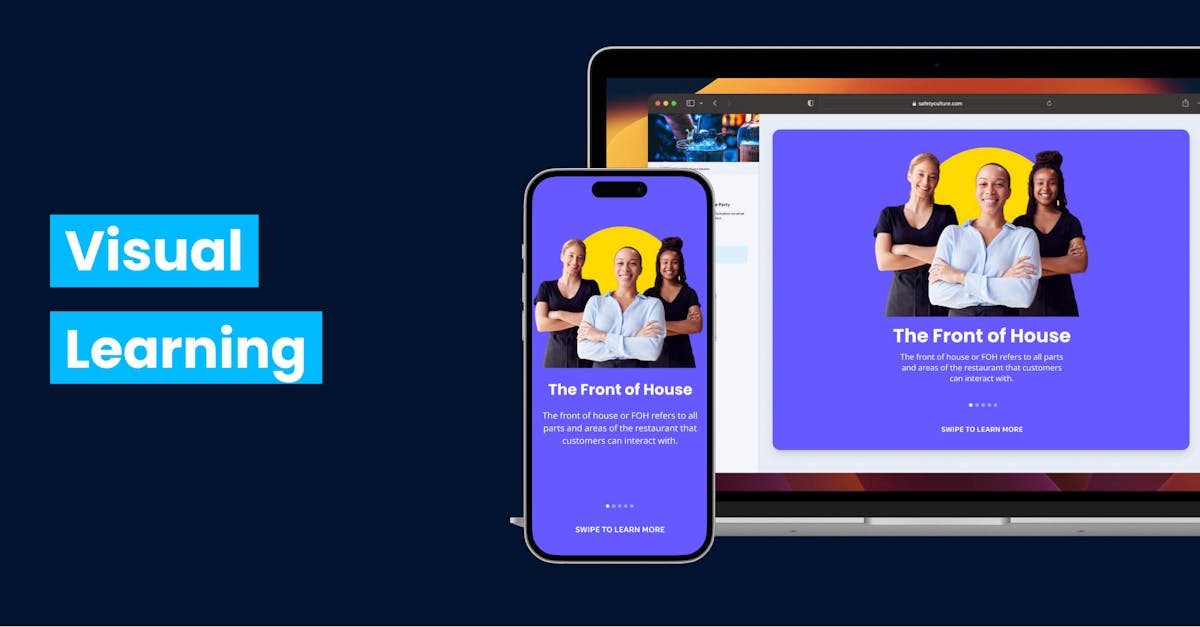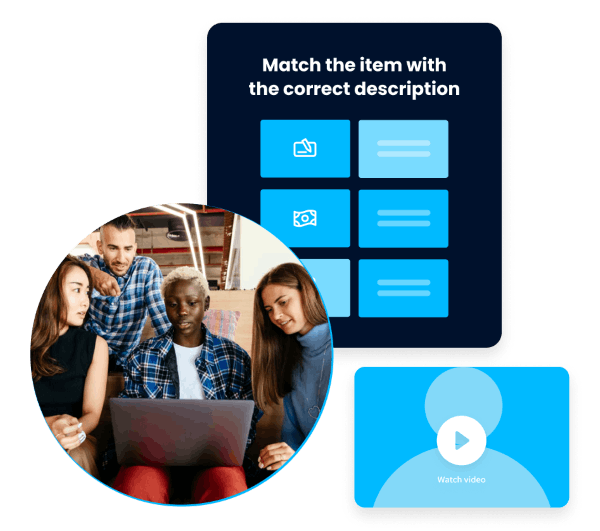Visual learning

Finding efficient learning techniques has become essential in today’s digital age, where information is readily available but attention spans are shorter. Visual learning is one such strategy that is gaining popularity. In this article, we’ll explore what the visual learning style is and how it can improve learning.
What is visual learning?
Visual learning is a type of learning style where learners absorb and understand information better with the help of visual aids. It’s a type of learning that relies on visual stimuli, such as images, videos, diagrams, and other visuals.

Visual learning is an effective way to engage learners in the learning process and helps them understand complex concepts quickly. It’s especially useful for visual learners or those who learn better with visual aids than with other media. Generally, it can help learners retain information better and make it easier to recall later on.
Sign up for free with EdApp today and start using the best LMS for visual learning
Why is visual learning important?
Visual learning is an important part of the learning process as it helps to engage learners in a more meaningful way. It helps to make complex topics easier to understand and encourages learners to think critically about the information they are presented with.

Visuals can also be used to give context and relevance, making it easier for learners to remember what they’ve learned. Additionally, visuals can help make lessons more interactive and engaging, allowing learners to explore the material in a more creative way.
Visual learning benefits

Including visual elements in learning materials can enhance the learning experience and cater to learners' varying needs and preferences. Let’s take a look at the benefits of visual learning below:
- Enhanced comprehension: Visuals such as images, diagrams, charts, and graphs can help learners understand complex information more easily. Visual representations can simplify abstract concepts and make them more concrete and accessible.
- Improved retention: Research suggests that incorporating visuals into learning materials can enhance memory retention. Visuals can stimulate the brain and make information more memorable, leading to better recall and retrieval.
- Increased engagement: Visuals can captivate learners' attention and make the learning process more engaging and interactive. They add variety to the learning experience, preventing monotony and enhancing motivation.
- Facilitates learning styles: Visual learning caters to individuals who have a preference for visual information. Some learners understand and process information more effectively when presented in visual form, enabling them to grasp and retain knowledge more efficiently.
- Supports multi-sensory learning: Visuals can be combined with other sensory experiences, such as auditory and kinesthetic elements, to create a multi-sensory learning environment. This approach can deepen understanding and reinforce learning through multiple channels.
Visual Learning Examples

Images
The use of powerful images creates strong impressions and lasting memories in learners. It helps them make sense of the content and direct attention while increasing the possibility of retaining information. With images, connections are realized and complex concepts can be simplified.
Videos
Video learning is easily a great way to boost learner engagement, especially when entertaining elements are incorporated into it. It takes out the mundane task of having to sit in a classroom and listen to lectures for hours by helping visualize and place context to the information you’re absorbing.
Games
In the midst of our technological age, it has become increasingly difficult to keep individuals engaged in a captivating learning space. Gamified learning motivates learners, leads to better engagement with content, and is proven to enhance message retention.
Interactive text
Presenting and reinforcing key concepts through interactive and varied ways are perfect for visual learners as they get a hands-on learning approach. Interacting with their learning content helps stimulate a response and increases engagement with the training material.
Tables, charts, and graphs
These visual representations help learners grasp information in an organized and systematic manner. They’re best used in situations where you need to demonstrate important relationships or patterns. It helps visual learners understand data quicker and emphasize important information.
Using EdApp for visual learning
To create effective visual learning aids, you’ll need a learning solution that can pack a punch but isn’t complicated to use. EdApp is a visual learning software created to democratize learning. With EdApp, you’ll have access to a powerful creator tool right at your fingertips. It's designed to help you put together expertly-designed microlessons, without any prior technical expertise. You can choose from a variety of interactive templates and customize them to fit your specific needs.

The lessons you create using these templates are responsive and perfectly formatted for any device so you don’t have to worry about your layout as it adapts to whatever screen size is being used. Since EdApp is also mobile-first, it works on not just computers, but also mobile phones and tablets.
Want to transform your dull and boring presentations into engaging and interactive training? EdApp's PowerPoint Converter has got you covered! With just a few clicks, you can upload your PowerPoint and easily make changes in the creator tool, without the need for any design or coding skills. This saves a great deal of time and turns boring text into beautiful lessons that visual learners will love.
Author
Gabrielle Rivera
Gabrielle is an eLearning content writer for EdApp, a microlearning solution designed for today's digital habits. She creates content about cutting-edge learning technologies and resources to help companies deliver great training experiences. When not absorbed in writing, she spends her time playing video games and reading books.
